Step-by-step guide to growing potatoes in boxes
Potatoes are one of the most popular vegetable crops, grown in all regions. To get a big harvest, you need not only to choose the right variety, but also to put a lot of effort into caring for the plants. Planting potatoes in boxes or boxes is one of the experimental ways of growing a crop, allowing you to minimize labor costs without compromising productivity.
In this article we will tell you how to grow potatoes in boxes, including those with air supply.
Features of the method of growing potatoes in boxes
Crop yield depends on soil conditions, potato varieties and agrotechnical measures to care for them.
Tubers are formed at the ends of shoots-stolons extending from the stem. This means that their number directly depends on the length of the underground part of the stem, which can be increased by hilling.
Main advantages of the method Growing potatoes in boxes is an opportunity to significantly simplify the farmer’s task of caring for the crop and more efficiently use the area of the plot.
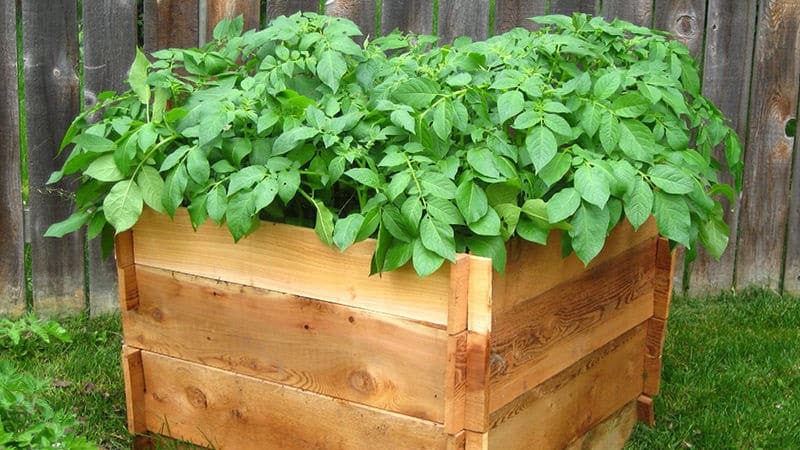
Description and essence of the method
The essence of the method is to plant potatoes not in the ground on the site, but in some container - for example, a box or box. As the plants grow, increase the height of the container and add soil mixture - this allows you to artificially increase the length of the roots and stimulate the formation of stolons.
If you follow all the recommendations and properly care for the plantings, the yield per bush is about 5 kg.
Are all varieties suitable?
For planting in boxes and boxes Potato varieties with a yield of at least 40 t/ha are suitable.
The most suitable varieties:
- Shante;
- Slav;
- Nevsky;
- Sineglazka;
- Lugovskoy;
- Reliable;
- Youth;
- American;
- Anosta;
- Belarus;
- Mona;
- Resi;
- Lukyanovsky;
- Amazon;
- Marfena;
- Ramono;
- Santa.
Advantages and disadvantages
The purpose of all alternative methods of growing potatoes – minimizing labor costs in crop care. Moreover, each method has not only positive, but also negative aspects.
According to experienced farmers, There are such advantages in unconventional methods of growing potatoes::
- high yield from each bush;
- no need for hilling, weeding, or preparing beds;
- saving site area;
- the box planting method is suitable for regions with arid climates;
- the risk of attack on bushes by Colorado beetles is eliminated;
- ease of harvesting;
- the possibility of using the method in both open and closed conditions.
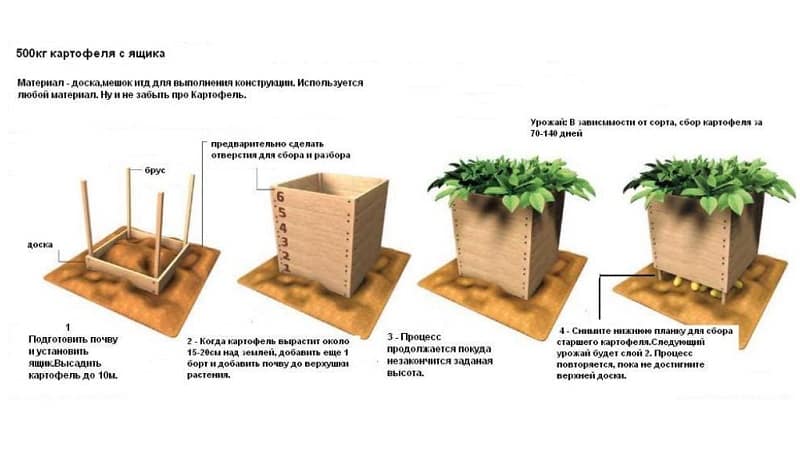
Flaws:
- the need to purchase or make boxes yourself;
- the possibility of slugs appearing in boxes or drawers;
- the need for specially prepared soil mixture;
- constant control of substrate humidity.
Necessary materials
To grow potatoes using this method, you will need standard gardening equipment.: bayonet shovel, glanders, rake, garden watering can, boxes and boxes.
Reference. Any plastic, wooden, glass or metal containers are used as boxes.
Conditions required for growing in boxes
Growing in boxes requires creating standard conditions for potatoes:
- air temperature +15…+25°C – at such indicators the above-ground part of the plant grows quickly and the growth of tubers is activated;
- humidity 70-80% - regular watering is necessary, especially after budding begins;
- intense lighting - this stimulates intensive photosynthesis of green mass, which has a positive effect on the yield and quality of tubers.
In the southern regions, potatoes are shaded – the combination of sunlight and high air temperature can negatively affect plant growth.
Technology of growing in boxes
Planting potatoes in boxes or boxes is a rather unusual way of growing a crop. It does not require much effort and time, but it has some features.
Selection and preparation of containers
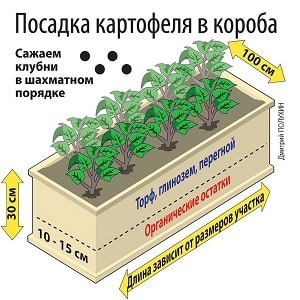 It is important that the container for planting potatoes is not toxic and had a size of at least 0.125 cubic meters.
It is important that the container for planting potatoes is not toxic and had a size of at least 0.125 cubic meters.
To make your own box you will need four wooden pegs approximately 0.5 m long and 20 wooden boards measuring 50x10 cm.
They are connected to each other to form a stable frame. Then thick plywood is attached to it, which will serve as the bottom.
Preparing tubers for planting
Tubers must be evenly colored, elastic, without damage or signs of rot.. It is better to choose medium-sized planting material, weighing about 50-80 g. Small tubers will give low yields, while large ones will devote energy to the development of the above-ground part.
Before planting tubers in the ground germinate – laid out in the light until small seedlings appear. Greened specimens are not discarded - during the growth process, the toxic solanine accumulated in them is naturally converted into safe substances.
Soil preparation
With this method, you cannot use ordinary soil from the site – it will not provide the plants with the necessary nutrients and, under such conditions, has extremely low air permeability.
A light and nutritious substrate based on peat is suitable – it is responsible for creating the most suitable microclimate and nutritional balance and retains moisture during the dry period. To reduce acidity and improve the quality of the soil mixture, peat is diluted by a quarter with river sand, and then 70-80 g of limestone flour is added for every 10 kg of mixture.
You can mix turf soil and humus in equal proportions or compost, then add a glass of wood ash to 10 kg of such soil.
Important! You cannot take soil from the place where potatoes were previously planted because of the likelihood that it contains toxins, pest larvae and infectious agents.
When to land
Considering that the growing season of potatoes is 3-4 months, and the optimal air temperature for the development of tubers and green parts is +15...+25°C, the optimal time for planting tubers is May.
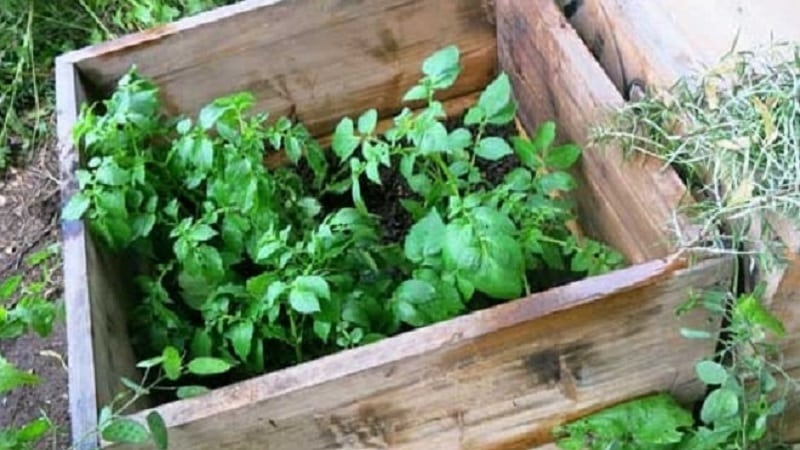
Landing technology
The method of growing crops in boxes is in many ways similar to the traditional method., but still has some nuances.
Landing technology:
- Install boxes in the chosen location.
- Place a brick at each corner to create a small and well-ventilated foundation.
- Place paper on the bottom of the boxes, pour a mixture of humus and expanded clay on top (layer thickness - 5-10 cm).
- Place the sprouted tubers in the boxes, keeping a distance of 15-20 cm between them.
- Cover them with prepared soil mixture and mulch the ground with straw or moss.
When the sprouts reach a height of 10 cm, they are covered with soil again. and do this until budding begins.
Further care
Potatoes in boxes do not require labor-intensive care and needs standard agrotechnical measures: watering, fertilizing, protection from diseases and pests.
Top dressing
Fertilizing scheme:
- two weeks after planting the tubers - a solution of mullein or chicken manure with the addition of urea;
- at the beginning of active growth of green mass and the formation of tubers - potassium-phosphorus fertilizers;
- 20 days before harvest - a mixture of manure and superphosphate.
Fertilizers applied at the root or sprayed them the green part of plants.
Watering mode
Potatoes are watered once every 7-10 days at the rate of 5-10 liters of water per container. It is important that the entire substrate down to the lower layers is moist. At the same time, it should not be allowed to become waterlogged - this leads to the development of putrefactive processes.
Watering is carried out in the morning or evening to prevent excessive evaporation of moisture.
Protection from diseases and pests
To prevent the development of diseases and pest attacks, plants are treated 2-3 times per season. insecticidal and fungicidal preparations - for example, "Aktara", "Confidor" or "Prestige".
Important! Treatment begins no earlier than a month after planting.
What difficulties can you encounter when growing in boxes?
When cultivating potatoes in boxes, the following problems may arise::
- rotting of root crops in case of excessive watering - this can be avoided by removing the bottom of the box or making holes in it;
- drying out of plants due to loss of moisture in the absence of mulching;
- poor growth and development of culture if the boxes are placed incorrectly - for example, in the shade.
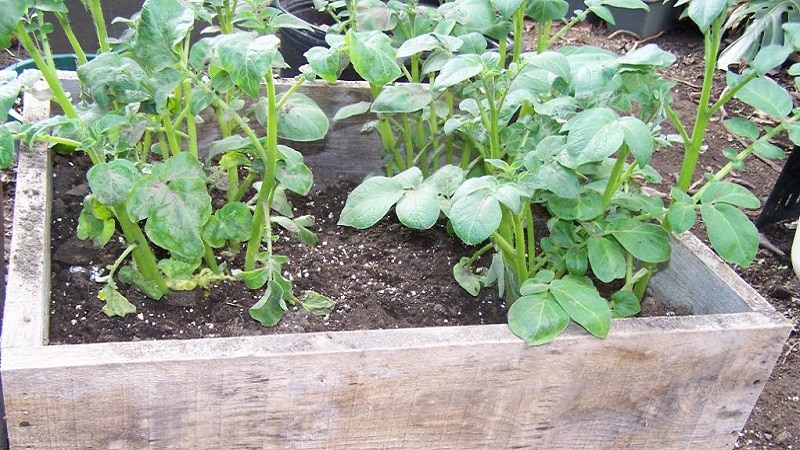
When and how to harvest
Under optimal climatic conditions, potatoes in boxes ripen in 3-4 months after planting the tubers - in central Russia this is most often mid-September. Dried tops indicate the readiness of the crop for harvesting.
Reference. Under favorable weather conditions, the harvest can remain in boxes until the beginning of October.
To harvest, simply disassemble the box and empty the contents. An additional advantage of this method of growing potatoes is that all the tubers remain clean, undamaged by a shovel or fork.
Tips and tricks from experienced gardeners
Experienced farmers recommend:
- About 10-15 days before harvesting, cut the tops off the potatoes - this will allow the tubers to ripen better and the skin to become dense.
- To prevent early budding, water the soil mixture with compost and protect the plants from excessive sunlight.
- When planting tubers in early spring, cover the boxes with agrofibre or film.
Conclusion
Growing potatoes in boxes is a popular technology. Farmers often use this method because it allows them to minimize labor costs, save space on the plot, and at the same time get a rich harvest. It is important to choose a suitable potato variety and high-quality seed, and not to neglect the rules of crop care. Then you will certainly have a rich and healthy harvest!